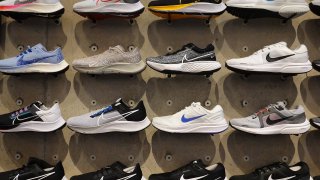
- Nike's post-earnings comments Monday could be a harbinger of how other retailers are seeing the impact of a war overseas, sky-high oil prices and inflationary pressures.
- The sneaker giant is set to report its results for the fiscal third quarter after the market closes, amid global unrest and clogged supply chains.
- Nike's exposure to China is also under a microscope, as the U.S. may choose to impose serious consequences if Beijing helps Russia wage its war against Ukraine and Western brands face continued boycotts throughout Asia.
Nike's post-earnings comments Monday could be a harbinger of how the retail industry is being affected by the war in Ukraine, sky-high oil prices and inflationary pressures that threaten to curtail consumer spending.
The sneaker giant is set to report its results for the fiscal third quarter after the market closes. Nike's exposure to China is also under a microscope, as the United States may choose to impose consequences if Beijing helps Russia wage its war against Ukraine and Western brands face continued boycotts throughout Asia.
Nike shares have traded down in recent weeks, as investors anticipate the retailer taking a hit from some of the aforementioned risks. The stock closed Friday at $131.24, down 21% year to date, compared with the S&P 500's decline of 6%, and off a 52-week high of $179.10. Still, some analysts say shares can fall even further.
Get Southern California news, weather forecasts and entertainment stories to your inbox. Sign up for NBC LA newsletters.
Nike is expected to report 2022 fiscal third-quarter revenue of $10.6 billion, on earnings of 71 cents per share, according to a survey of analysts by Refinitiv.
Here are some of the key topics analysts are watching and expecting Nike to address later Monday.
Outlook poised to disappoint
Money Report
UBS analyst Jay Sole thinks Nike's fourth-quarter and initial fiscal 2023 outlooks, should the retailer offer them, are going to disappoint investors.
"Our checks suggest Nike's China business is not recovering as fast as we, or the market, expected," Sole wrote in a note to clients. Plus, he said, the market has been underestimating the effects of the persistent global supply chain challenges that have delayed manufacturing and shipments, Nike's temporary suspension of business in Russia, higher oil prices and a rising U.S. dollar that will pressure Nike's forecast for profits.
Earlier this month, Nike said that given the rapidly evolving situation in Russia, along with increased operational challenges, it paused its business there. At this point, it's unclear how long that will persist. The company has 116 retail stores in Russia, representing less than 2% of its total sales, according to analysts' estimates.
"We think Nike's third-quarter report will cause the market to see the company's earnings rebound happening later than currently believed," said Sole.
Analysts polled by Refinitiv see Nike's total sales growing 2.3% in the fourth quarter compared with a year earlier. For fiscal 2023, Wall Street anticipates Nike's sales will amount to $53 billion, up 13% from the prior year.
China risk
Barclays analyst Adrienne Yih said the bigger and longer-term obstacle for Nike will be China, which accounted for 19% of Nike's sales in fiscal 2021, which ended on May 31.
In early 2021, sales at brands including Nike and its rival Adidas plunged in China due to a boycott among Chinese citizens of Western brands. The outrage was sparked over allegations of forced labor in the cotton industry around the Xinjiang region, where Uyghur Muslims are a prominent minority group. These allegations were denied by the Chinese government, but brands including Nike took a stance of not using Xinjiang cotton.
When Nike reported its second-quarter results in late December, Chief Financial Officer Matt Friend told analysts on a conference call that Nike was seeing "encouraging signs" in China. Still, the company expected fiscal 2022 to be a year of recovery in the region, he said. Later on the call, Chief Executive John Donahoe said Nike was taking the long-term view in China and creating new products that are tailored to the Chinese consumer.
Nike may not see a positive catalyst until June or later, said Morgan Stanley analyst Kimberly Greenberger.
She flagged the recent renewed Covid lockdowns in China as another risk for Nike and its peers.
"[China] has been a focus point for investors in the last year amidst the boycotts and inventory challenges, with investors specifically debating whether underperformance is demand or supply driven," wrote Greenberger, in a note to clients. "It's unlikely third-quarter results resolve these lingering debates."
Separately, Citi retail analyst Paul Lejuez said his team conducted a survey of 1,000 Chinese consumers earlier this month to gauge how they feel about Nike compared with other brands, including those based in China. The poll found that Chinese consumers continue to rate Chinese sportswear brands, such as Li Ning, as in line with or better than Western brands. However, he said that Nike and Adidas appear to be in relatively good standing.
Wholesale distribution plans
Also on analysts' and investors' radar is Nike's commentary around its relationships with wholesale partners. The athletic footwear giant has been pursuing a clear shift toward selling more of its shoes and apparel directly to consumers, rather than through third parties, in a bid to boost profits and raise affinity for its brand.
Foot Locker, one of Nike's biggest vendor partners, disclosed in late February that its mix of sales from Nike will fall from 65% in the fourth quarter of 2021 to 55% in the fourth quarter of 2022, with a chance it will drop even lower.
Analysts at Credit Suisse have estimated that this could account for a loss of between $600 million and $800 million in wholesale revenue for Nike in fiscal 2023.
"While we didn't think Nike would pivot so quickly as to disrupt Foot Locker's cash flows so meaningfully, we understand why Nike would want those sales represented through its owned channels," said Credit Suisse analyst Michael Binetti.
As of Nov. 30, direct-to-consumer revenue accounted for roughly 41% of Nike's overall business. Investors will be looking for more color on how that figure could keep growing from here and what partners Nike will remain most reliant on.






